Toast and TouchBistro are excellent point-of-sale (POS) systems designed especially for restaurants. Our POS experts score these systems multiple times a year across dozens of restaurant-specific criteria for our restaurant POS rankings. Both are great choices, but TouchBistro tends to be a more templatized, user-friendly system while Toast is more customizable and offers much broader features that micro-operations (like food trucks) may not use.
In a nutshell:
- TouchBistro: Best for smaller operations, restaurants with simple inventories, and those preferring iPads
- Toast: Best for growing restaurants of all types, especially those wanting expansive online ordering, delivery, and workforce management tools
TouchBistro vs Toast at a Glance
Our rating | 3.64 out of 5 | 4.16 out of 5 |
Available in | USA, Canada, UK, Ireland | |
Best for | Small restaurants, food trucks, iPad users | Growing restaurants, fast food, delivery |
Monthly fees | From $69 per terminal | |
Processing fees | Varies by processor | From 2.49% + 15 cents |
Contract length | 1 year | 2 years |
Restaurant features | Very good | Excellent |
Integrations/extensions | Good | Very good (restaurant-focused) |
Ease of use | Excellent | Excellent |
Customer support | 24/7 year-round via phone, email, or online chat, resource library | 24/7 year-round via phone, email, or online chat, Toast University, resource library |
4.18 | 4.19 | |
We’ve been impressed with both Toast and TouchBistro for many years. You’ll find them on several of our best POS lists:
- Best Restaurant POS Systems
- Best POS Systems for Small Business
- Best Delivery POS Systems
- Best Food Truck POS Systems
- Best Quick Service Restaurant POS Systems
- Best Bar & Nightclub POS System
TouchBistro vs Toast: Alternatives
If you want a different combination of hardware and payment options—an iPad POS with additional payment processing options or a smaller-scale POS with non-iPad hardware—the systems below will be a better fit for you.
Best for | Software pricing | Compatible hardware | Available processors | Our review | |
|---|---|---|---|---|---|
Quick-service restaurants (QSRs) and detailed reporting | $69–$399+ | iPads, Android devices | Lightspeed Payments, BridgePay, Cayan, and WorldPay | Lightspeed Restaurant review | |
Cafes and coffee shops; ease of use | $0–$60+ | iPads or Square Registers and Terminals | Square Payments | Square for Restaurants review | |
Both of the systems listed above operate on iPads, though Square for Restaurants also uses Square-designed registers and terminals.
If you feel that either Toast or TouchBistro will be your best fit, though, read on to see how they performed across our scoring criteria. Let’s start with the most basic difference: each system’s price.
Best for Pricing: TouchBistro
TouchBistro outscored Toast due to slightly more favorable contract terms, earning a 2.25 out of 5 in this category to Toast’s 2 out of 5. TouchBistro’s contracts are only one year (Toast’s requires two years), and as an iPad-based POS, users are more likely to be able to reuse existing POS components they already own (though you’ll need to check with TouchBistro for compatibility).
But if you look past Toast’s contract terms, the system may be less expensive for you. Toast offers a free baseline POS subscription while TouchBistro doesn’t even offer a free trial. Toast users also have several options to pay as they go for hardware and additional software.
Our score | 2.25 out of 5 | 2.25 out of 5 |
Monthly subscription fees | ||
Contract length | 1 year | 1 year |
In-person/advanced support installation fee | Custom | Custom |
In-person transaction fee | Custom-quoted | Custom-quoted |
Online transaction fee | Custom-quoted | Custom-quoted |
Digital ordering | $50 per month | $50 per month |
Loyalty program | $99 per month | $99 per month |
Reservations | $229 per month | $229 per month |
Gift cards | $25 per month | $25 per month |
Marketing | $99 per month | $99 per month |
Inactivity fee | None | None |
TouchBistro’s add-on pricing is easy to understand. Its fees are monthly flat-rate prices, so it is easy to budget for. And they clearly list most of their add-on fees on their website.
Toast users have the option to pay for add-ons for each available subscription. The number of pricing options can make budgeting a little confusing; it can be hard to tell which arrangement is better for your business. Toast is also not very forthcoming with the price of each add-on if you’re getting them separately from the Growth plan. Still, it’s hard to argue with the $0 upfront option.
Hardware
TouchBistro and Toast operate on very different hardware. Toast operates on industry-grade, Toast-designed touch-screen tablets and peripherals. TouchBistro, on the other hand, relies on iPads for POS terminals, KDS screens, customer-facing displays, and tableside order and payment devices. Toast offers a wider range of hardware options, though. If you want self-service kiosks and digital ordering displays, Toast is the only option.
Baseline Countertop Terminal | 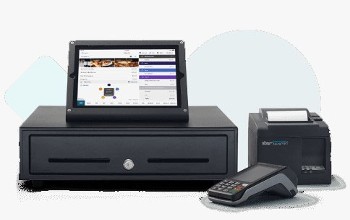 Custom-quoted |  $875 upfront or $69 per month; or $0 with 2.99% +15 cents processing fee |
Handheld Terminal | 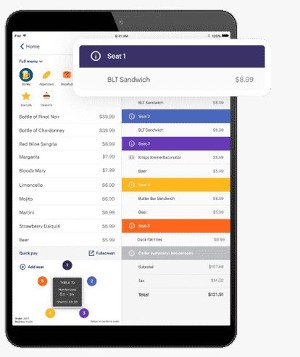 Hardware fees only; custom-quoted | 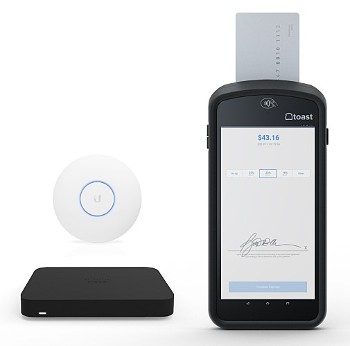 $627 upfront or $69 per month; or $0 with 2.99% +15 cents processing fee |
KDS Screen | 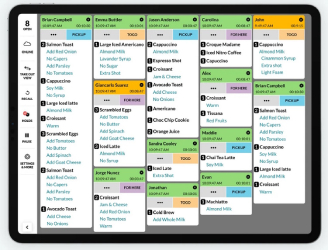 Custom-quoted | 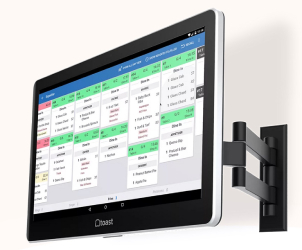 $499 + $25 per month |
Self-service Kiosk | No self-service kiosk available | 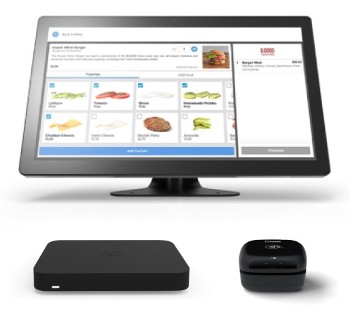 $1,009 upfront or $99 per month; or $0 with 2.99% +15 cents processing fee |
Toast offers easy payment plans and pay-as-you-go options for up to two terminals. TouchBistro requires custom quotes for its hardware, with no pay-as-you-go options. TouchBistro also does not support self-ordering kiosks. So, if kiosks are a must-have, Toast is a better bet.
Payments
TouchBistro and Toast are tied on payments. Both systems lock new users into their built-in payment processing systems, TB Payments and Toast Payments. Toast, however, lists its processing fees publicly, while TouchBistro requires a custom quote.
Payment types | Credit, debit, check | Credit, debit, check, mobile wallets, and automated clearing house (ACH) |
In-person processing rates | Custom quoted | 2.49%–2.99% + 15 cents |
Pre-authorized bar tabs | ✓ | ✓ |
Quick Response (QR) codes | ✓ | ✓ |
Invoices | ✓ | ✓ |
Online payments | ✓ | ✓ |
Offline payments | ✓ | ✓ |
Toast Payments rates start at 2.49% + 15 cents per transaction for customers who pay upfront for hardware. High-volume restaurants can also request a custom rate quote, which will likely be lower. Though, with Toast, you can pay for additional software and hardware purchases by agreeing to higher processing fees, which can help small restaurants get advanced tools with no money down.
Our Expert Take: Choose TouchBistro when you want simple built-in payment processing, need a shorter contract, or prefer iPads. Choose Toast when you want to use processing fees to pay for hardware or additional services, if you want to get started for $0 upfront or pay-as-you-go with your processing fees, or if you need self-service kiosks or industry-grade hardware.
Best for General Features: Toast
Toast scored higher than TouchBistro in this category (4.13 vs 3.44) because the former includes more customizable reports and much more expansive workforce management tools. TouchBistro’s reports are mostly templatized, and some are only available on the POS, the back-office dashboard, or as PDFs.
TouchBistro also acts as a time clock to record your employees’ hours, but it falls well short of Toast’s full-spectrum employee management, which includes automated tip pool calculations, scheduling, and even onboarding paperwork.
Our score | 3.44 out of 5 | 4.13 out of 5 |
Reporting | Templated | Customizable; advanced |
Inventory | ✓ | Requires a separate subscription to xtraCHEF (custom-quoted price) |
Order modifications | ✓ | ✓ |
Course management | ✓ | ✓ |
Scheduling | Via integration | ✓ |
Time clock | ✓ | ✓ |
Time-off management | Via integration | ✓ |
TouchBistro includes real-time, ingredient-level inventory tracking in the baseline POS. Toast no longer includes this; Toast users have the option to add on the xtraCHEF by Toast app to their POS for a custom-quoted fee.
This is where things get a little nuanced; if you plan to track your inventory in real time, Toast’s inventory tool is functionally a lot stronger and easier to use. But, it costs more. TouchBistro includes ingredient-level inventory, but the module needs a lot of manual updating to stay current and is a little clunky to use.
Our Expert Take: If general POS functionality is your highest priority, choose TouchBistro when you need a simple system with few bells and whistles, and basic inventory and reporting are enough. Choose Toast when you need customizable reports, robust workforce management, and user-friendly inventory management.
Best for Niche POS Features: Toast
Toast has many, many more advanced features than TouchBistro. Most of them are optional add-ons and come with additional monthly fees. If you need automated tip pool management, a system that alerts you of local labor law conflicts when you are creating employee schedules, Toast is your best option.
If the advanced tool you need is built-in reservations without the need for a third-party integration, both systems offer full-functioning reservations modules. You can add TouchBistro Reservations or Toast Tables for additional monthly software fees.
Our score | 2.29 out of 5 | 4.58 out of 5 |
Payroll processing | Via integration | Add-on |
Reservations | Add-on | Add-on |
In-house delivery management | ✓ | ✓ |
Maps-based driver dispatch | ✕ | ✓ |
Work with delivery services | ✓ | ✓ |
Throttle orders | ✓ | ✓ |
Social sales | ✓ | ✓ |
SMS texting to customers | ✓ | ✓ |
Automated Tip Pool Management | ✕ | ✓ |
When it comes to online ordering, TouchBistro and Toast are closely aligned—in fact, both make it to our list of the top delivery POS systems. Both have an online ordering system that handles pickup or delivery and lets people order from your website or social media pages.
With either system, you can add wait times to throttle orders, so your kitchen staff doesn’t get overwhelmed. The information integrates with your marketing and loyalty programs (if you have them). Though Toast’s driver management tools are more robust, with map-based driver dispatch.
Both POS systems integrate with delivery systems through third-party apps. Toast has 11 integrations. Some are direct, such as Grubhub or DoorDash, and some are aggregators, like ItsaCheckmate. TouchBistro, meanwhile, only uses the aggregator Deliverect, which comes with extra monthly fees.
Our Expert Take: Choose TouchBistro when you need basic, user-friendly built-in reservations and basic online ordering. Choose Toast when you need more complex reservations tools, comprehensive delivery management, maps-based driver dispatch, and detailed tip management tools.
Best for Ease of Use: Tie
If you want an easy-to-use POS software for your restaurant, you can’t go wrong with either solution. Both have excellent user interfaces for your waitstaff and administrators. Toast may take longer to set up than TouchBistro, but that depends on the complexity of your menu and inventory.
Visit TouchBistro | Visit Toast | |
Our score | 5 out of 5 | 5 out of 5 |
Onboarding help | Optional, custom-quoted fee | Optional; custom-quoted fee based on hardware type and restaurant size |
Store/restaurant setup | Easy and quick (few hours) | Good (can take weeks) |
Live support | 24/7 year-round via phone, email, or online chat | 24/7 year-round via phone, email, or online chat |
Online help articles | ✓ | ✓ |
Video tutorials | ✓ | ✓ |
Advanced training | ✕ | Toast University |
Website setup | ✓ | ✓ |
Personal assistance | ✓ | ✓ |
4.2 | 4.2 |
Real-world users give these systems a tie when looking at ease of use. Both earned a 4.2 out of 5 just on customer support. This is an excellent score for SaaS in general and above average for restaurant POS systems.
We give kudos to both Toast and TouchBistro for having 24/7 year-round live help via phone, email, or online chat. Their help sections are thorough and include illustrations and videos. Both services go beyond how to use the software with white papers on many aspects of restaurant management.
Toast provides some additional help, such as with online setup. TouchBistro offers personal help remotely, while Toast has in-person assistance and training available for a fee. Toast also offers many training modules in Spanish and English.
Our Expert Take: If ease of use is your deciding factor, choose TouchBistro when you need a quick setup. Choose Toast when you need in-person training and Spanish-language training materials.
Best for Expert Score: Toast
Both TouchBistro and Toast are excellent, user-friendly POS systems. In general, though, TouchBistro is better for simpler restaurant operations. Those with a small footprint, like a food truck or a high-volume counter-service restaurant, will love this iPad-based system. In our restaurant evaluation, TouchBistro earned a 4.38 out of 5 for expert score.
Toast offers a ton of standout features for every possible restaurant type—it scored a 5 out of 5 in this category. The four distinct subscription options ensure that large operations have everything they need, while small guys don’t pay for tools they won’t use.
Are you still undecided? If neither of these systems seems like a fit and you’re still looking for the best POS for your restaurant, take the quiz below to see our expert recommendation. You won’t need to enter any personal information, and your results will appear on this page:
Find the Best POS System for Your Restaurant
Methodology: How We Evaluate Restaurant POS Systems
When comparing Toast vs TouchBistro, we considered more than 20 criteria that are important to small, independent restaurants. We grade all restaurant POS systems multiple times a year using the same standards. Click through the criteria below for more information.
20% of Overall Score
We look for systems that offer a baseline subscription below $75 per month and offer built-in payment processing along with third-party processing options. Systems that offer free baseline subscriptions, free trials, and contract lengths that are one year or less get extra points.
20% of Overall Score
We look for all the functionality a restaurant needs for check, order, and menu management. We also rate workforce management and scheduling; reporting; and integrations. We give the highest points to systems that include fundamentals like ingredient-level inventory in the baseline POS without additional charges.
15% of Overall Score
This is where we rate standout features like online ordering, delivery management, loyalty, tipping tools, and bar and kitchen features.
30% of Overall Score
We rate customer service type (live phone, chat, or email) and hours. We also look for installation support and offline payment processing.
15% of Overall Score
We rate each system’s standout features, value for money, and popularity with restaurants. We also consider our experience testing the software.
TouchBistro vs Toast Frequently Asked Questions (FAQs)
Here are the answers to some commonly asked questions about TouchBistro vs Toast.
A POS system designed specifically for restaurants can have a monthly fee ranging from $0 to over $160. Sometimes this base fee will get you industry specific features like digital menus; online ordering; and menu, table, and order management. At other times, you may need to pay additional fees for these features. Custom pricing may also be available for your chosen POS system.
TouchBistro offers transparent and flat-rate pricing; optional built-in features for loyalty and online ordering; and a user-friendly interface.
Toast offers a free subscription option; pay-as-you-go pricing for hardware; restaurant-specific payroll management; and an option for easy-to-use, real-time, ingredient-level tracking.
Bottom Line
When it comes to Toast vs TouchBistro, Toast is overall a more complete software and better suited for larger restaurants, like sit-down eateries with large menus or with a bar or lounge attached. TouchBistro, meanwhile, is a little simpler and faster to set up, but is by no means meager in its features. It’s a great choice for smaller restaurants, food trucks, and those who don’t need extensive inventory, and who like the convenience of an iPad-run software.